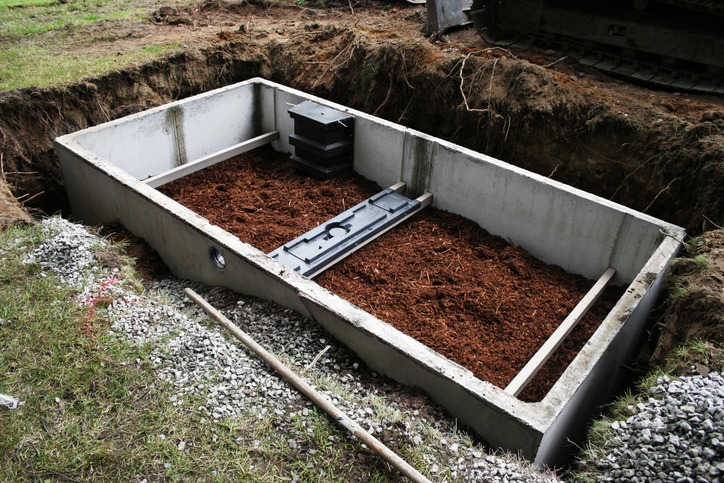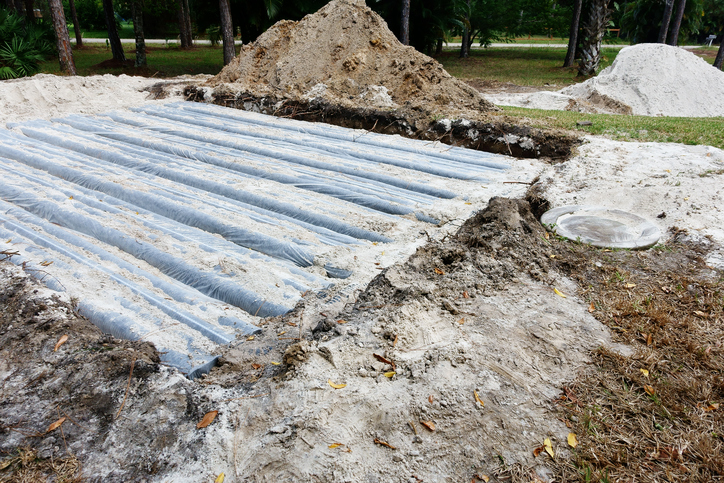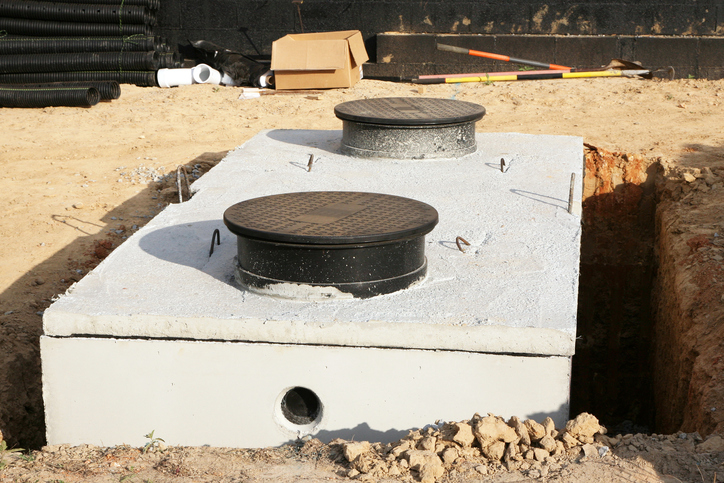Everything You Need To Know About Your Septic System
Thirty percent of Florida residents rely on nearly 2.6 million septic systems to dispose of waste and wastewater each day. Homes and businesses in rural areas rely on these systems for efficient and effective waste removal.
What Are Septic Tanks Made From?
Septic tanks are a watertight box made from concrete, fiberglass, or polyethylene material. This means no debris, soil, or water from the surrounding ground can enter the tank. Concrete and/or fiberglass septic tanks are the most materials.
Common Styles Of Septic Tanks
Aerobic Treatment Unit (ATU)
ATUs use three compartments — a trash compartment, aeration chamber, and clarifying compartment — to treat and filter waste. Compressed air is forced through effluent, creating an aerobic, or well oxygenated, environment for microbe growth. As the microbes thrive in this environment, waste breaks down more than in a standard septic tank. This reduces the amount of organic material entering the surrounding soil and groundwater.
Double Compartment
Most tanks installed since 1976 have two compartments to filter effluent, the solids and wastewater entering the tank. Generally, the first compartment is larger than the second compartment, located next to the intake pipe. Liquid from the first compartment flows through a pipe into the second compartment. Remaining sludge and scum separate from the liquid before effluent moves through the outflow pipe.

Pump Tank
A pump tank controls the amount of effluent flowing from the septic tank. As effluent collects in the pump tank, the level rises until it reaches the control float. When the float activates, the pump sends a predetermined volume of effluent into the drain field.
Holding Tank
Holding tanks are an alternative to septic tanks and hold waste. These tanks are above or below ground and need frequent pumping to remove the contents. Most holding tanks have an alarm that sounds when the tank is full.
Single Compartment
Most septic systems installed before 1976 used a single compartment tank. These tanks had capacities up to 1,000 gallons. Waste flows into the tank and separates into three layers before liquid waste enters the septic drain field through the outflow pipe.
What Is FOG?
Fats, oils, and grease, or FOG, are common byproducts of cooking and naturally occur in many foods and other products. While FOG is generally viscous as it enters the septic tank, it cools rapidly as it intermingles with wastewater. But, the viscosity also means FOG coats and covers any surface as it solidifies.
How A Septic Tank Works
Effluent enters the tank through the intake pipe; solids settle to the bottom while FOG rises to the top of the wastewater. Generally, the tank is large enough to hold wastewater long enough to allow effulent separation to occur.
This separation creates three layers inside the tank — a sludge layer on the bottom, wastewater in the middle, and a scum layer on top. Bacteria, enzymes, and other microbes generally found in human waste begin to break down the sludge layer. But, the microbes are unable to decompose all solids which eventually leads to septic tank pump outs as the bottom layer increases in depth. Two baffles direct and filter what enters the septic tank and drain field. The intake baffle prevents the scum layer from clogging the inflow pipe while scum and solids are kept in the tank by the outflow baffle.
What Are Septic Tank Solids?
Most solids found in a septic tank fall into one of three categories:
- Biodegradable organic solids, such as solid human waste;
- Slow biodegradable organic solids, such as vegetable scraps and other cellulosic compounds and toilet paper; and
- Non-biodegradable solids, such as pet litter, plastics, and other materials that don’t break down over time.
Septic System Drain Fields
What Is A Drain Field?
When effluent exits the septic tank, it flows into an area of underground pipes and soil called the drain field. Other common terms include absorption field, leach field, and trench. How big the area needs to be depends on:
- Soil type;
- Seasonal changes in the groundwater level;
- Amount of water absorbed each day; and
- Soil percolation rate.
The soil percolation rate is how much water the soil can absorb in one minute per one inch of soil. Because Florida has a high water table, the percolation rate is an important factor in deciding the location of the septic drain field.

How A Drain Field Works
This area contains a system of perforated pipes located in either multiple trenches or a gravel-lined soil bed. Wastewater drains from the pipes and filters through the gravel and soil. Soil compaction greatly affects its function which is why it’s important to never build on or drive or park vehicles of any size over this area.
Why Is A Drain Field Important?
It acts as a natural filter for the wastewater which recycles back into the groundwater supply. Without this filtration, biological and chemical contaminants could enter the water and cause health issues when a person either ingested or came into contact with the water.
How To Find Your Septic Tank & Septic Drain Field
Most property diagrams and surveys will show where the septic system is located. These may have been provided to you during the sale of the home or business but are also kept on file with the county government office.
The septic tank is usually installed along the sewer line that extends from the home. This line is several inches in diameter and found in the lowest level of the home, such as a basement or crawl space. Follow the pipe out of the home and stick a metal probe in the ground every two feet along the sewer line. Most septic tanks are between 10 feet and 25 feet from the home or business. Use the probe to locate the edges of the septic tank lid — most tanks are 5 feet by 8 feet in size. The drain field begins on the far edge of the tank and may extend up to 100 feet from the tank.
If you find the system location differ from previously created diagrams or maps, make sure to update these materials and keep a copy for your records.
The Septic Tank Pumping Process
First, the floating scum layer is broken up by alternately drawing out the liquid from the tank then pumping it back in to break up the bottom solid layer for extraction. Pumping is done through the two access ports, called manholes. The tank should never be pumped through the baffle inspection ports. This can not only damage the baffles but incompletely remove waste from the tank. Industrial vacuums suction waste from the tank and into our tanker truck until the septic tank is empty.
How Often A Septic Tank Should Be Pumped?
Generally, every three to five years. But you may need to call a septic tank pumping company such as Jones Plumbing & Septic Tank Service sooner depending on septic tank capacity and the daily volume of solids and wastewater.
What To Expect During A Septic Tank Pumping
The scum and sludge thickness should be measured before pumping begins. This information is useful in assessing the accumulation rate for waste and provides an estimate when to schedule the next pumping. During the pumping process, our technicians are actively looking for any potential issues with the system, such as backflow from the outflow pipe. Considerable backflow usually signals a backup in the drainfield while some backflow signals a weakened outflow pipe. Once the septic tank is empty, it’s ready for cleaning and waste is taken to a state-approved disposal location.
Septic Tank Cleaning
Though many people use the terms interchangeably, septic tank cleaning is different from septic tank pumping. Pumping merely removes liquid and uncompressed solids while cleaning removes remaining solids before washing the inside of the tank.
Once the liquid layer has been vacuumed from the tank, our technicians use pressurized streams of water to break up remaining solids. An industrial-grade vacuum and attached hose remove the solids before the inside of the tank is rinsed. If any solids linger in the tank, they slowly cause cracks and leaks in the bottom of the tank. This can lead to sinkhole development or full system failure. Our technicians inspect it for any structural defects and will provide repair recommendations.
How Often Should A Septic Tank Be Cleaned?
With every septic tank pump out. Remember the frequency of tank pumping depends on how many people are using the system and the volume of wastewater generated on a daily basis. A septic tank pumping company, such as Jones Plumbing & Septic Tank Service, can help you set up a regular pumping and cleaning schedule.
How To Keep A Septic Tank In Good Condition Between Cleanings
The best way to keep your septic tank in good condition for many years is to be aware of what can and can not go into the septic system.
Don’t Dispose & Flush Items At-Will
A septic system relies on naturally occurring microbes to decompose solids that enter the tank. Yet, it’s a symbiotic relationship easily thrown out of balance depending on what materials are being disposed of. Fat, oil, and grease (FOG); chemicals, paints, fuels, and/or motor oils; disposable diapers, sanitary, and personal hygiene products; and coffee grounds and egg and nut shells are common household items that should never enter a septic system.
Schedule Annual Inspections
Home and business owners can inspect the exterior of the septic system themselves. But, the tank and internal components should only be inspected by a certified and trained septic tank company such as Jones Plumbing & Septic Tank Service. Toxic fumes and gases form inside a septic system and can be fatal if a person doesn’t have appropriate safety equipment and training.
Walk around the septic tank location and look for patches of unusually thick grass; sewage odors or smells; and unexplained standing water. These signs are frequently associated with damaged septic systems.
Pump & Clean The Tank As Necessary
Skipping scheduled septic tank services is a recipe for a preventable mess. Routine pumping and cleaning let our technicians assess the health of the system and repair any issue before it causes a big problem.
Keep Records Of Septic Location & Service
Knowing where the entire system is located is the first step in system maintenance. Never park or drive vehicles over any part of the septic system as vehicle weight can cause the system to collapse. When this happens, the only repair is a full replacement. Jones Plumbing & Septic Tank Service also recommends keeping records of when the system was inspected, pumped, and cleaned for your information and in case the property is sold in the future.
Conserve Water
The amount of water entering a septic system has a larger impact on the system’s health than the amount of generated solids. The more water that flows through the drain field, the shorter functional lifespan it and the entire system has. Too much water flow prevents proper separation of solids inside the tank, increasing the risk of clogged intake and outflow pipes that cause sewage backups.
Septic Tank Repair In Gainesville, FL
Common Septic Tank Issues
Excess Water In The Tank
Too much water in the septic tank means there’s a higher risk of solids being carried into the pipes, potentially clogging the system.
Aggressive Tree Roots
Tree roots are notorious for causing issues with septic systems. Septic tanks are strong, but many types of tree roots are stronger — strong enough to crack the pipes and tank, causing leaks and other structural damage.
Common Septic Tank Repairs
Drain Field Piping
The pipes can break for several reasons, including compacted and/or shifting soil. Once the pipes break, they must be quickly repaired to prevent serious drainage issues Excavation of the area is usually required to reach and repair the pipes.
Broken Baffles
The baffles in a septic tank keep solids inside the tank. Damage usually comes from rust or contact with sulfuric acid. An annual septic inspection is a great way to know if there are issues with the baffles before a problem develops.
How To Prevent A Septic Tank Failure
Septic systems aren’t infallible and greatly benefit from regular maintenance and care. Most failures are avoidable by watching what enters the plumbing and septic pipes.
Only Flush Toilet Paper
Toilet paper generally breaks down and dissolves more quickly than other common paper products. This is especially true of paper towels and wet wipes, two common culprits behind septic tank clogs and premature tank cleanouts.
Never Pour FOG Down The Drain
FOG is terrible for all plumbing, including the septic system. In liquid form, FOG flows freely into the septic tank and accumulates in the top scum layer. This might not sound like an issue but the concoction can easily flow into the drain field where it can create contamination issues with groundwater and the surrounding soil.
Regular Drain Cleaning
The many commercial drain cleaners available may temporarily clear a clogged drain and other plumbing but it’s at an enormous cost to the septic system. These cleaners contain chemicals that quickly destroy the microbes necessary for decomposing solids inside the septic tank. The layer of solids rapidly — and unnecessarily — builds. Instead, contact a plumber for professional drain cleaning. Most plumbing companies offer this service which should be done each year.
Septic Tank Installation
How To Tell When You Need A New Septic System
With proper maintenance and timely repairs as needed, a septic system may last 20 years to 40 years. Yet, if you notice these common signs of a failing septic system, it’s time to call Jones Plumbing & Septic Tank Service to install a new septic system. Common signs the current system needs to be replaced are:
- Slow draining sinks and toilets;
- Constantly backed up plumbing;
- Sewage odors in the business, home, or yard;
- Mushy, swampy, or wet patches in the yard;
- Standing gray water; and
- Localized grass that grows more quickly and deeper in color.

What To Know Before A Septic Tank Is Installed
Because improperly installed septic systems can contaminate water supplies and create public health issues, there are rules and regulations set forth by the state of Florida and local municipalities guiding new septic system installations.
Required Applications, Fees & Permits
The Florida Department of Health’s (FDOH) Environmental Health Service in Alachua County issues all necessary applications and permits. Before issuing a permit, the home or business owner must submit a completed application; site plan; building floor plan; and required application fees. A site evaluation is also required and assesses the property conditions, including soil type. Total fees are based on the type of septic system and services performed by the county health department.
Minimum Tank Size
Florida requires all septic tanks have a minimum 900-gallon capacity, but this capacity requirement increases depending on occupancy size and whether the system is for residential or commercial use. The technicians with Jones Plumbing & Septic Tank Service will help you determine an appropriately sized tank that meets state requirements.
Landscaping Changes
Since septic systems are underground, the current landscaping will likely need to be removed and relocated. Yet, our technicians may recommend installing the new system in a different location to avoid interference from plant and tree roots. The FDOH requires these distances be observed to prevent groundwater contamination from septic systems:
- 75 feet from the annual flood line of a permanent, non-tidal surface water body or from the high water line of a tidal body of water;
- 15 feet from a dry drainage ditch or stormwater retention area;
- 10 feet from stormwater pipes;
- At least 200 feet from public potable wells currently in use for non-residential or residential buildings with a total daily sewage flow of more than 2,000 gallons;
- At least 11 feet from water storage tanks in contact with potable or groundwater;
- At least 15 feet from a groundwater interceptor drain;
- At least 75 feet from bays, lakes, surface water, multi-family wells, and/or private potable wells; and
- At least 50 feet from non-potable wells.
New Home Construction & Septic Systems
Septic systems are installed for new homes built in rural areas or any area not served by a municipal sewer system. Any system being installed with new home construction will need to account for the factors and regulations listed above. Jones Plumbing & Septic Tank Service has installed septic systems for numerous new homes and is glad to assist you through the application and permitting process along with professionally installing the system.
